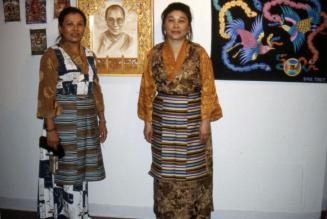Ngawang Choedar
At the age of 27 at the time of the Auspicious Signs project, Ngawang Choedar showed a remarkable skill in woodcarving. His father was a well-known Tibetan woodcarver and traditional architect from near Lhasa, who fled Tibet for Dharmasala, India. Ngawang inherited his father's love for wood, further developing his carving knowledge at the Tibetan Library in Dharmsala where he apprenticed for four years. Ngawang's teacher there was a monk from Kham in Tibet who both taught students and supervised them in making elaborate carved tables commissioned by monasteries in India and Japan. They also carved a wooden altar for the Dalai Lama. It could take as long as a year to finish a large table with several decorated panels carved with traditional Tibetan designs such as Buddhist symbols, mythological animals, and landscape scenes.
Ngawang brought his woodworking tools with him to Connecticut in 1992. He found a job in West Haven making specialized countertops, learning new techniques of industrial woodworking. The more delicate art of traditional Tibetan carving, as he learned it, is difficult to do in a small apartment even though Ngawang uses only his saw, whetstone, chisels, and the flat arm of a chair to create intricate, almost molded three-dimensional carved forms. Usually he carves pieces out of a soft pine called chil, easier to work than the hardwoods for furniture which require hammer and chisel.
After tracing designs (he uses many from his father) onto a flat piece of wood, Ngawang holds the wood with one hand while cutting shapes with his bamboo fret saw. This seemingly simple tool is ingenious and flexible, as it allows him to cut curved lines into tightly spaced shapes. By unstringing the serrated wire, threading it through a pierced hole in the center of the wood, then rewiring the saw, Ngawang can shape the middle of the wood block without cutting into it from the edge. Once the shapes are cut, depth and detail are added with a variety of gouges and chisels. To make a piece such as a large frame or table, individual panels or sections are carved, then assembled.
"The place I was born is near Mt. Everest. You can't see a lot of trees, you can't see lights, you can't see cars, you can't see anything! It's six or seven days walking through Nepal to the place I was born...my father built a monastery in that place. My dad and my teacher, they're the only ones who can draw the designs freehand and just carve it...that's why we need to keep all those designs they carved - write them down (copy them)...they learned all those designs in their lives and they are great."





